NMR, RP-HPLC-PDA-ESI-MSn, and RP-HPLC-FD Characterization of Green and Oolong Teas (Camellia sinensis L.)
Abstract
:1. Introduction
2. Results and Discussion
2.1. Untargeted NMR Analysis
2.2. RP-HPLC-PDA-ESI-MSn Analysis
2.3. Quantification of Targeted Bioactive Molecules by RP-HPLC-PDA
2.4. RP-HPLC-FD Analysis
3. Materials and Methods
3.1. Reagents and Materials
3.2. Sample Preparation for NMR analysis
3.3. NMR Analysis
3.4. Sample Preparation for Spectrophotometric and HPLC Analyses
3.5. RP-HPLC-PDA-ESI-MSn Analysis
3.6. RP-HPLC-PDA Analysis
3.7. Determination of Glutamic acid, Glutamine, γ-Amino Butyric Acid, and Theanine
3.8. Statistical Analysis
4. Conclusions
Supplementary Materials
Author Contributions
Funding
Institutional Review Board Statement
Informed Consent Statement
Data Availability Statement
Conflicts of Interest
Sample Availability
Abbreviations
References
- Yarmolinsky, J.; Gon, G.; Edwards, P. Effect of tea on blood pressure for secondary prevention of cardiovascular disease: A systematic review and meta-analysis of randomized controlled trials. Nutr. Rev. 2015, 73, 236–246. [Google Scholar] [CrossRef] [PubMed]
- Rahmani, A.H.; Al shabrmi, F.M.; Allemailem, K.S.; Aly, S.M.; Khan, M.A. Implications of green tea and its constituents in the prevention of cancer via the modulation of cell signalling pathway. Biomed. Res. Int. 2015, 2015, 1–12. [Google Scholar] [CrossRef] [PubMed]
- Shang, A.; Li, J.; Zhou, D.-D.; Gan, R.-Y.; Li, H.-B. Molecular mechanisms underlying health benefits of tea compounds. Free Radic. Biol. Med. 2021, 172, 181–200. [Google Scholar] [CrossRef]
- Zhang, L.; Ho, C.; Zhou, J.; Santos, J.S.; Armstrong, L.; Granato, D. Chemistry and biological activities of processed Camellia sinensis teas: A comprehensive review. Compr. Rev. Food Sci. Food Saf. 2019, 18, 1474–1495. [Google Scholar] [CrossRef] [Green Version]
- Xing, L.; Zhang, H.; Qi, R.; Tsao, R.; Mine, Y. Recent advances in the understanding of the health benefits and molecular mechanisms associated with green tea polyphenols. J. Agric. Food Chem. 2019, 67, 1029–1043. [Google Scholar] [CrossRef]
- Xu, C.; Liang, L.; Li, Y.; Yang, T.; Fan, Y.; Mao, X.; Wang, Y. Studies of quality development and major chemical composition of green tea processed from tea with different shoot maturity. LWT 2021, 142, 111055. [Google Scholar] [CrossRef]
- Zhu, H.-B.; Li, B.-M.; Liu, C.; Chen, R.-Y. Chemical constituents of Camellia sinensis var. assamica. Zhongguo Zhong Yao Za Zhi 2013, 38, 1386–1389. [Google Scholar]
- Drynan, J.W.; Clifford, M.N.; Obuchowicz, J.; Kuhnert, N. The chemistry of low molecular weight black tea polyphenols. Nat. Prod. Rep. 2010, 27, 417–462. [Google Scholar] [CrossRef]
- Del Rio, D.; Stewart, A.J.; Mullen, W.; Burns, J.; Lean, M.E.J.; Brighenti, F.; Crozier, A. HPLC-MSn analysis of phenolic compounds and purine alkaloids in green and black tea. J. Agric. Food Chem. 2004, 52, 2807–2815. [Google Scholar] [CrossRef]
- Ku, K.M.; Kim, J.; Park, H.-J.; Liu, K.-H.; Lee, C.H. Application of metabolomics in the analysis of manufacturing type of pu-erh tea and composition changes with different postfermentation year. J. Agric. Food Chem. 2010, 58, 345–352. [Google Scholar] [CrossRef] [PubMed]
- Zulli, A.; Smith, R.M.; Kubatka, P.; Novak, J.; Uehara, Y.; Loftus, H.; Qaradakhi, T.; Pohanka, M.; Kobyliak, N.; Zagatina, A.; et al. Caffeine and cardiovascular diseases: Critical review of current research. Eur. J. Nutr. 2016, 55, 1331–1343. [Google Scholar] [CrossRef]
- Harbowy, M.E.; Balentine, D.A.; Davies, A.P.; Cai, Y. Tea Chemistry. CRC Crit. Rev. Plant Sci. 1997, 16, 415–480. [Google Scholar] [CrossRef]
- Chen, Y.; Zeng, L.; Liao, Y.; Li, J.; Zhou, B.; Yang, Z.; Tang, J. Enzymatic Reaction-Related Protein Degradation and Proteinaceous Amino Acid Metabolism during the Black Tea (Camellia sinensis) Manufacturing Process. Foods 2020, 9, 66. [Google Scholar] [CrossRef] [Green Version]
- Di Lorenzo, A.; Nabavi, S.F.; Sureda, A.; Moghaddam, A.H.; Khanjani, S.; Arcidiaco, P.; Nabavi, S.M.; Daglia, M. Antidepressive-like effects and antioxidant activity of green tea and GABA green tea in a mouse model of post-stroke depression. Mol. Nutr. Food Res. 2016, 60, 566–579. [Google Scholar] [CrossRef]
- Daglia, M.; Di Lorenzo, A.; Nabavi, S.F.; Sureda, A.; Khanjani, S.; Moghaddam, A.H.; Braidy, N.; Nabavi, S.M. Improvement of antioxidant defences and mood status by oral GABA tea administration in a mouse model of post-stroke depression. Nutrients 2017, 9, 446. [Google Scholar] [CrossRef] [Green Version]
- Engelhardt, U.H. Tea chemistry—What do and what don’t we know?—A micro review. Food Res. Int. 2020, 132, 109120. [Google Scholar] [CrossRef]
- Gotti, R.; Furlanetto, S.; Lanteri, S.; Olmo, S.; Ragaini, A.; Cavrini, V. Differentiation of green tea samples by chiral CD-MEKC analysis of catechins content. Electrophoresis 2009, 30, 2922–2930. [Google Scholar] [CrossRef]
- Meng, W.; Xu, X.; Cheng, K.-K.; Xu, J.; Shen, G.; Wu, Z.; Dong, J. Geographical origin discrimination of oolong tea (TieGuanYin, Camellia sinensis (L.) O. Kuntze) using proton nuclear magnetic resonance spectroscopy and near-infrared spectroscopy. Food Anal. Methods 2017, 10, 3508–3522. [Google Scholar] [CrossRef]
- Wang, C.; Zhang, C.; Kong, Y.; Peng, X.; Li, C.; Liu, S.; Du, L.; Xiao, D.; Xu, Y. A comparative study of volatile components in Dianhong teas from fresh leaves of four tea cultivars by using chromatography-mass spectrometry, multivariate data analysis, and descriptive sensory analysis. Food Res. Int. 2017, 100, 267–275. [Google Scholar] [CrossRef]
- Mannina, L.; Sobolev, A.P.; Di Lorenzo, A.; Vista, S.; Tenore, G.C.; Daglia, M. Chemical composition of different botanical origin honeys produced by Sicilian black honeybees (Apis mellifera ssp. sicula). J. Agric. Food Chem. 2015, 63, 5864–5874. [Google Scholar] [CrossRef]
- Mannina, L.; Sobolev, A.P.; Coppo, E.; Di Lorenzo, A.; Nabavi, S.M.; Marchese, A.; Daglia, M. Antistaphylococcal activity and metabolite profiling of manuka honey (Leptospermum scoparium L.) after in vitro simulated digestion. Food Funct. 2016, 7, 1664–1670. [Google Scholar] [CrossRef]
- Marchese, A.; Coppo, E.; Sobolev, A.P.; Rossi, D.; Mannina, L.; Daglia, M. Influence of in vitro simulated gastroduodenal digestion on the antibacterial activity, metabolic profiling and polyphenols content of green tea (Camellia sinensis). Food Res. Int. 2014, 63, 182–191. [Google Scholar] [CrossRef]
- Wang, L.Y.; Wei, K.; Jiang, Y.W.; Cheng, H.; Zhou, J.; He, W.; Zhang, C.C. Seasonal climate effects on flavanols and purine alkaloids of tea (Camellia sinensis L.). Eur. Food Res. Technol. 2011, 233, 1049–1055. [Google Scholar] [CrossRef]
- Lee, J.-E.; Lee, B.-J.; Chung, J.-O.; Hwang, J.-A.; Lee, S.-J.; Lee, C.-H.; Hong, Y.-S. Geographical and climatic dependencies of green tea (Camellia sinensis) metabolites: A 1H NMR-based metabolomics study. J. Agric. Food Chem. 2010, 58, 10582–10589. [Google Scholar] [CrossRef] [PubMed]
- Lee, J.-E.; Lee, B.-J.; Chung, J.-O.; Kim, H.-N.; Kim, E.-H.; Jung, S.; Lee, H.; Lee, S.-J.; Hong, Y.-S. Metabolomic unveiling of a diverse range of green tea (Camellia sinensis) metabolites dependent on geography. Food Chem. 2015, 174, 452–459. [Google Scholar] [CrossRef]
- Lee, J.-E.; Lee, B.-J.; Hwang, J.; Ko, K.-S.; Chung, J.-O.; Kim, E.-H.; Lee, S.-J.; Hong, Y.-S. Metabolic dependence of green tea on plucking positions revisited: A metabolomic study. J. Agric. Food Chem. 2011, 59, 10579–10585. [Google Scholar] [CrossRef]
- Le Gall, G.; Colquhoun, I.J.; Defernez, M. Metabolite profiling using 1H NMR spectroscopy for quality assessment of green tea, Camellia sinensis (L.). J. Agric. Food Chem. 2004, 52, 692–700. [Google Scholar] [CrossRef]
- Tarachiwin, L.; Ute, K.; Kobayashi, A.; Fukusaki, E. 1H NMR based metabolic profiling in the evaluation of Japanese green tea quality. J. Agric. Food Chem. 2007, 55, 9330–9336. [Google Scholar] [CrossRef]
- Ghosh, A.K.; Ghosh, C.; Gupta, A. A Simple Approach To Detect Caffeine in Tea Beverages. J. Agric. Food Chem. 2013, 61, 3814–3820. [Google Scholar] [CrossRef]
- Daglia, M.; Lorenzo, A.; Nabavi, S.; Talas, Z.; Nabavi, S. Polyphenols: Well beyond the antioxidant capacity: Gallic acid and related compounds as neuroprotective agents: You are what you eat! Curr. Pharm. Biotechnol. 2014, 15, 362–372. [Google Scholar] [CrossRef]
- Clifford, M.N.; Johnston, K.L.; Knight, S.; Kuhnert, N. Hierarchical scheme for LC-MS n identification of chlorogenic acids. J. Agric. Food Chem. 2003, 51, 2900–2911. [Google Scholar] [CrossRef]
- Lin, L.-Z.; Chen, P.; Harnly, J.M. New Phenolic Components and Chromatographic Profiles of Green and Fermented Teas. J. Agric. Food Chem. 2008, 56, 8130–8140. [Google Scholar] [CrossRef] [Green Version]
- Dou, J.; Lee, V.S.Y.; Tzen, J.T.C.; Lee, M.-R. Identification and comparison of phenolic compounds in the preparation of oolong tea manufactured by semifermentation and drying processes. J. Agric. Food Chem. 2007, 55, 7462–7468. [Google Scholar] [CrossRef]
- Nonaka, G.; Kawahara, O.; Nishioka, I. Tannins and related compounds. XV. A new class of dimeric flavan-3-ol gallates, theasinensins A and B, and proanthocyanidin gallates from green tea leaf. (1). Chem. Pharm. Bull. 1983, 31, 3906–3914. [Google Scholar] [CrossRef] [Green Version]
- Liu, H.; Zou, T.; Gao, J.; Gu, L. Depolymerization of cranberry procyanidins using (+)-catechin, (−)-epicatechin, and (−)-epigallocatechin gallate as chain breakers. Food Chem. 2013, 141, 488–494. [Google Scholar] [CrossRef] [PubMed]
- Dai, W.; Qi, D.; Yang, T.; Lv, H.; Guo, L.; Zhang, Y.; Zhu, Y.; Peng, Q.; Xie, D.; Tan, J.; et al. Nontargeted analysis using ultraperformance liquid chromatography—Quadrupole time-of-flight mass spectrometry uncovers the effects of harvest season on the metabolites and taste quality of tea (Camellia sinensis L.). J. Agric. Food Chem. 2015, 63, 9869–9878. [Google Scholar] [CrossRef]
- Li, F.; Ohnishi-Kameyama, M.; Takahashi, Y.; Yamaki, K. Tea Polyphenols as Novel and Potent Inhibitory Substances against Renin Activity. J. Agric. Food Chem. 2013, 61, 9697–9704. [Google Scholar] [CrossRef] [PubMed]
- Chiu, F.-L.; Lin, J.-K. HPLC analysis of naturally occurring methylated catechins, 3′ ′- and 4′ ′-methyl-epigallocatechin gallate, in various fresh tea leaves and commercial teas and their potent inhibitory effects on inducible nitric oxide synthase in macrophages. J. Agric. Food Chem. 2005, 53, 7035–7042. [Google Scholar] [CrossRef] [PubMed]
- Zheng, X.Q.; Jin, J.; Chen, H.; Du, Y.Y.; Ye, J.H.; Lu, J.L.; Lin, C.; Dong, J.J.; Sun, Q.L.; Wu, L.Y.; et al. Effect of ultraviolet B irradiation on accumulation of catechins in tea (Camellia sinensis (L) O. Kuntze). Afr. J. Biotechnol. 2008, 7, 3283–3287. [Google Scholar] [CrossRef]
- Horžić, D.; Komes, D.; Belščak, A.; Ganić, K.K.; Iveković, D.; Karlović, D. The composition of polyphenols and methylxanthines in teas and herbal infusions. Food Chem. 2009, 115, 441–448. [Google Scholar] [CrossRef]
- Yu, Z.; Yang, Z. Understanding different regulatory mechanisms of proteinaceous and non-proteinaceous amino acid formation in tea (Camellia sinensis) provides new insights into the safe and effective alteration of tea flavor and function. Crit. Rev. Food Sci. Nutr. 2020, 60, 844–858. [Google Scholar] [CrossRef] [PubMed]
- Chen, Y.; Fu, X.; Mei, X.; Zhou, Y.; Cheng, S.; Zeng, L.; Dong, F.; Yang, Z. Proteolysis of chloroplast proteins is responsible for accumulation of free amino acids in dark-treated tea (Camellia sinensis) leaves. J. Proteom. 2017, 157, 10–17. [Google Scholar] [CrossRef]
- Sasaoka, K.; Kito, M.; Onishi, Y. Some Properties of the Theanine Synthesizing Enzyme in Tea Seedlings. Agric. Biol. Chem. 1965, 29, 984–988. [Google Scholar] [CrossRef]
- Lin, Z.; Lin, Z.M.; Yin, J.F.; Tan, J.F. Influence of anaerobic treatment on the amount of c-aminobutyric acid and the quality of tea leaf. Food Sci. 2004, 25, 35–39. [Google Scholar]
- Tsushida, T.; Murai, T. Conversion of glutamic acid to GAMMA-aminobutyric acid in tea leaves under anaerobic conditions. Agric. Biol. Chem. 1987, 51, 2865–2871. [Google Scholar] [CrossRef] [Green Version]
- Guo, X.; Song, C.; Ho, C.-T.; Wan, X. Contribution of l-theanine to the formation of 2,5-dimethylpyrazine, a key roasted peanutty flavor in Oolong tea during manufacturing processes. Food Chem. 2018, 263, 18–28. [Google Scholar] [CrossRef] [PubMed]

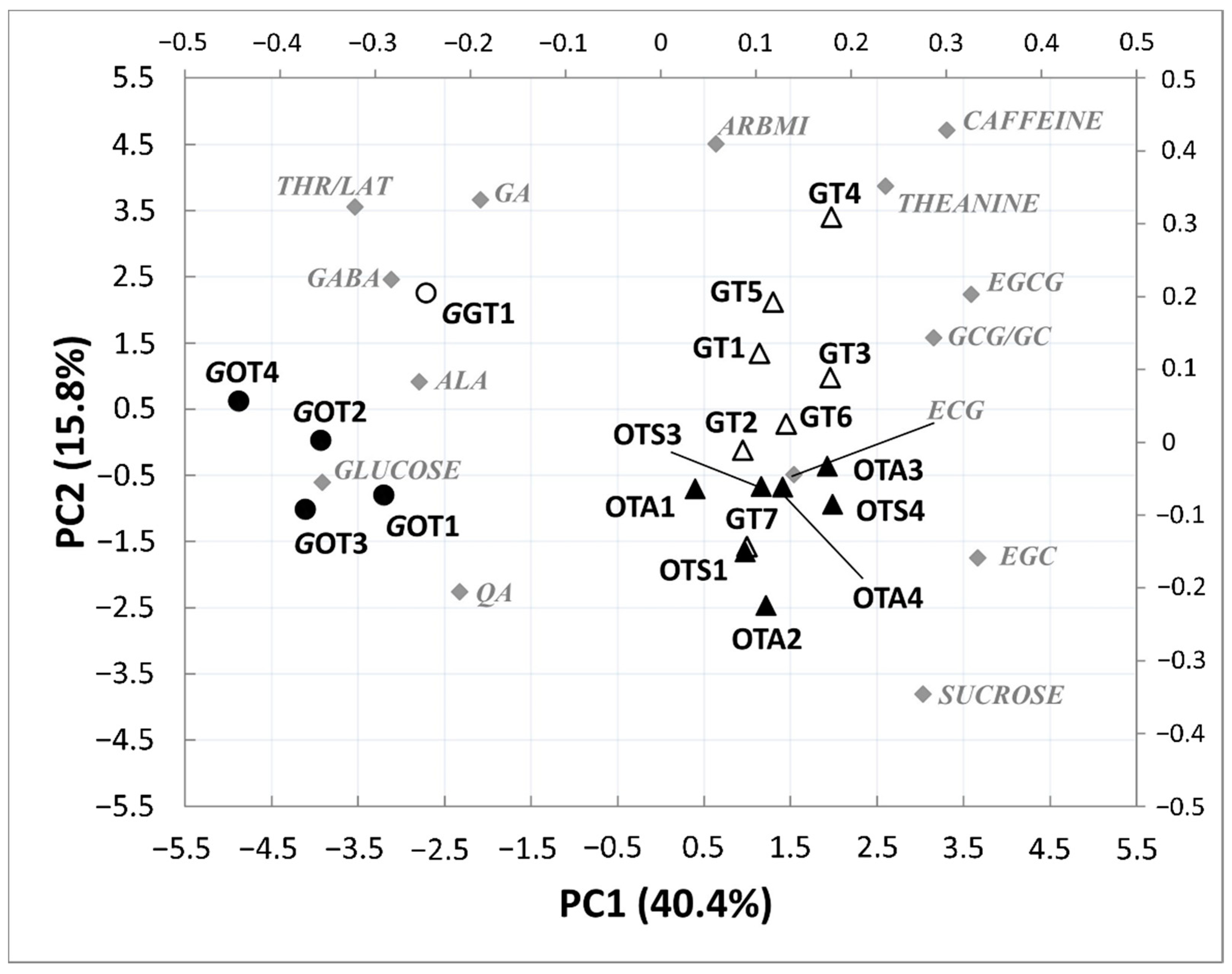
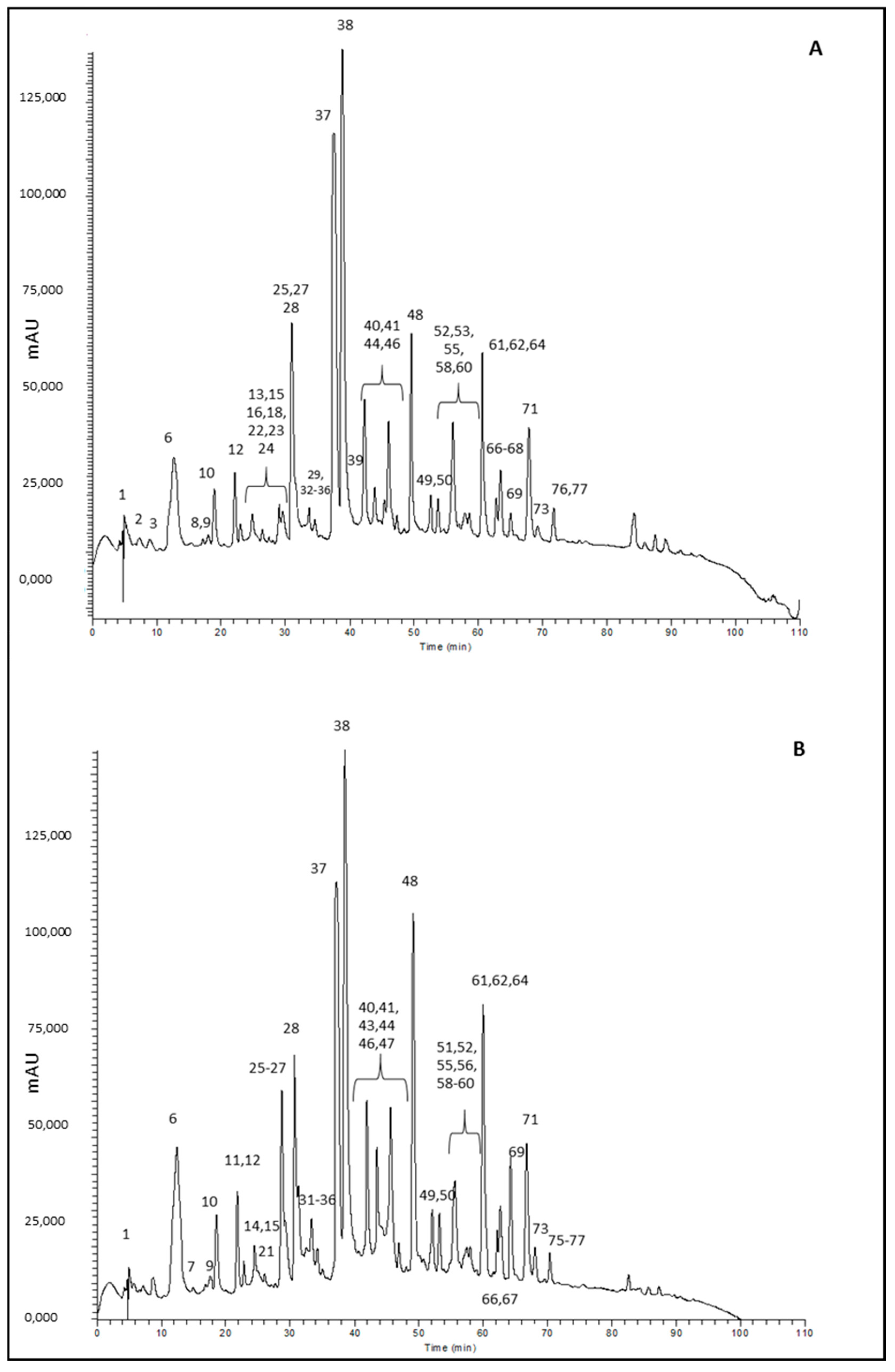
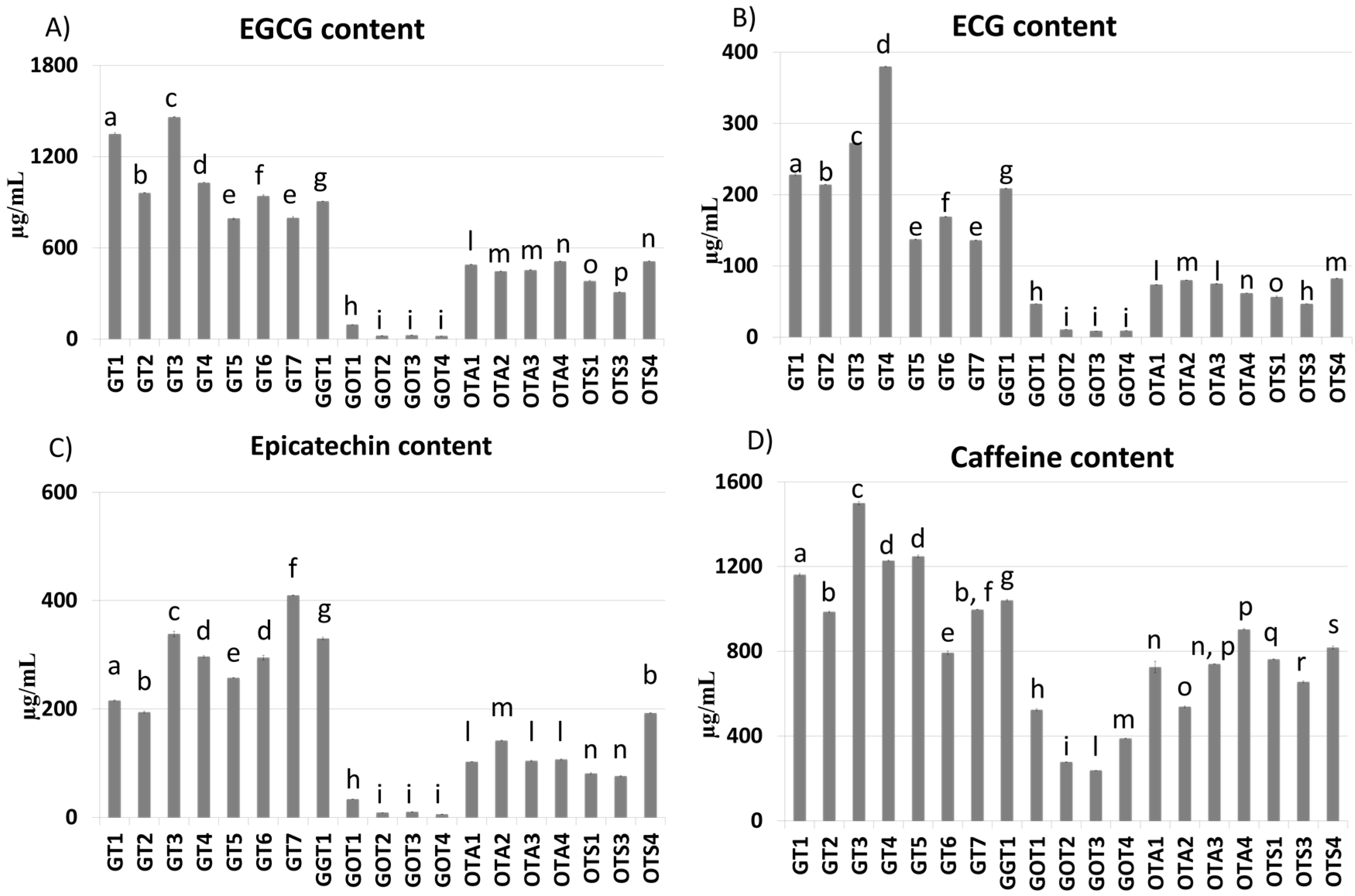
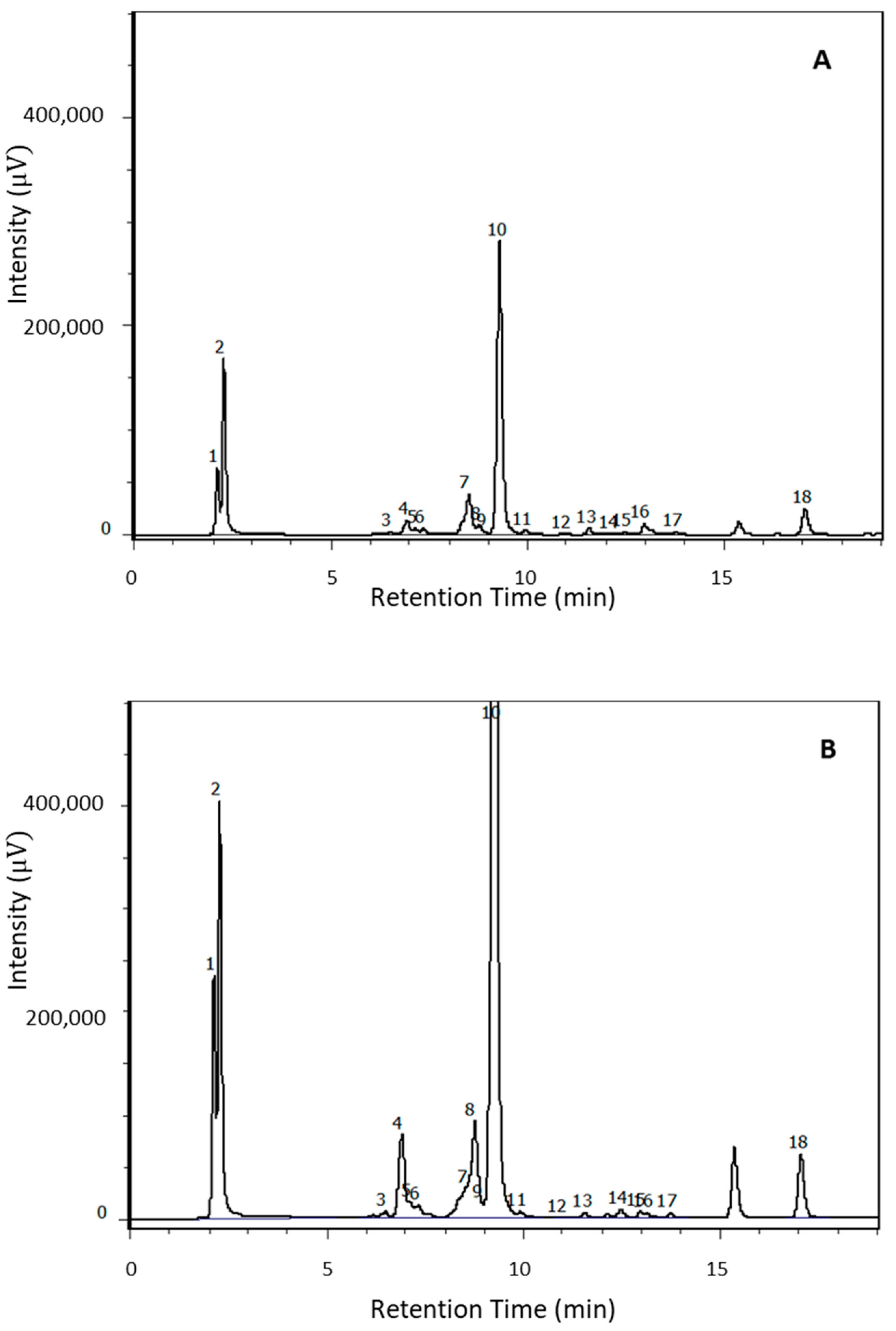
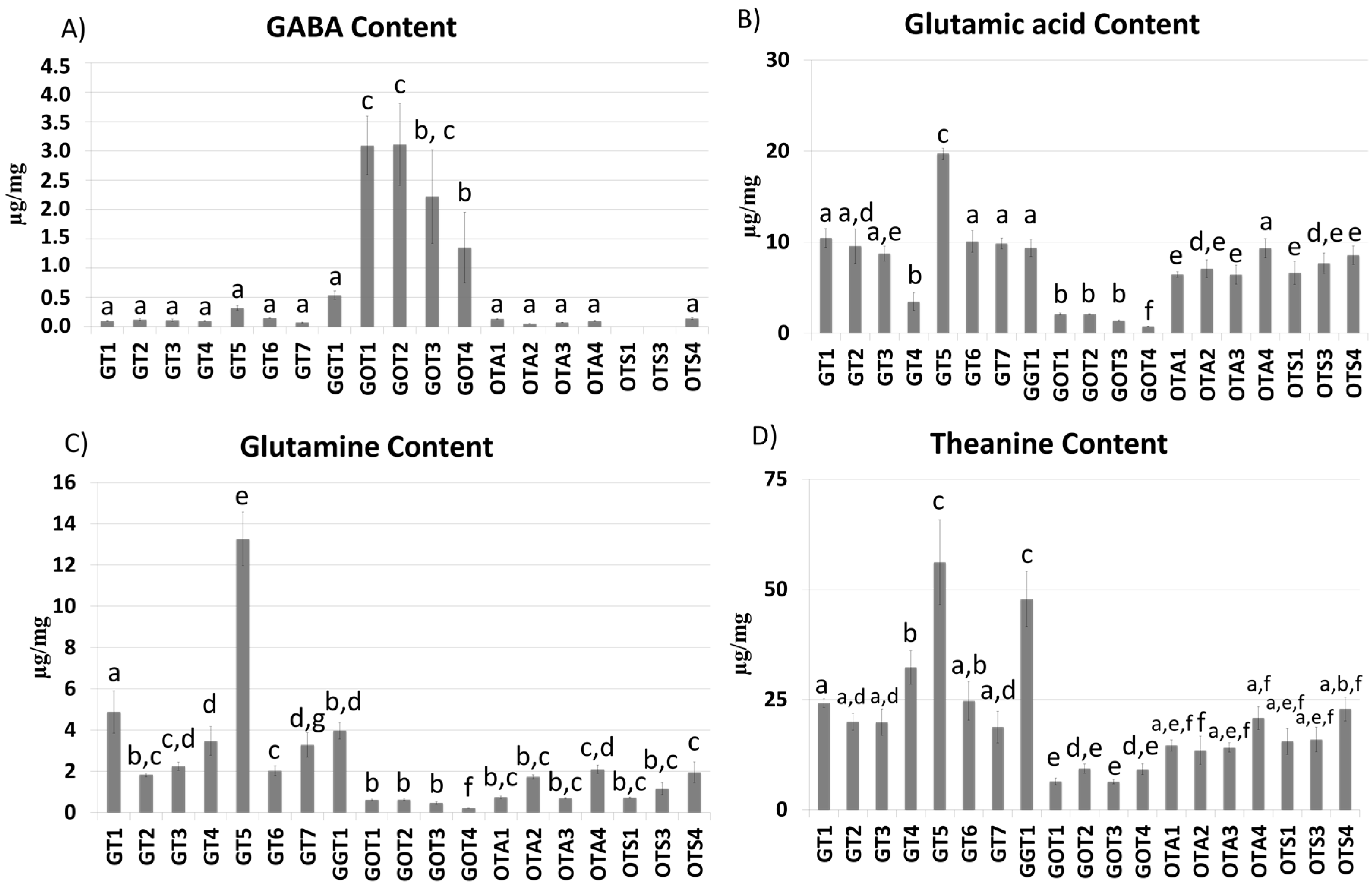
| N. | Tea Sample | Abbreviation | Degree of Fermentation | Country of Origin | Infusion Parameter | Dry Residue (mg/50 mg) |
|---|---|---|---|---|---|---|
| 1 | Lung Ching | GT1 1 | Green | China | 85 °C 3 min | 12.3 |
| 2 | Gunpowder | GT2 | Green | Zhejiang Province (China) | 85 °C 3 min | 10.5 |
| 3 | Mao Feng | GT3 | Green | Anhui Province (China) | 85 °C 4 min | 17.0 |
| 4 | Jade Snow | GT4 | Green | Guangxi region (China) | 80 °C 4 min | 11.1 |
| 5 | Kabusecha | GT5 | Green | Japan | 70 °C 2 min | 13.7 |
| 6 | Sencha | GT6 | Green | Japan | 80 °C 2 min | 12.7 |
| 7 | Gyokuro Kyushu | GT7 | Green | Japan | 75 °C 2 min | 13.9 |
| 8 | GABA green | GGT1 2 | Green | Japan | 80 °C 2 min | 11.2 |
| 9 | Dong Ding | OTA1 3 | Low degree of fermentation | Taiwan | 85 °C 4 min | 7.9 |
| 10 | Anxi Ti Kuan Yin | OTA2 | Low degree of fermentation | Fujian region (China) | 85 °C 4 min | 8.2 |
| 11 | Si Ji Chun | OTA3 | Low degree of fermentation | Taiwan | 85 °C 4 min | 8.0 |
| 12 | Wenshan Baozhong | OTA4 | Low degree of fermentation | Taiwan | 85 °C 4 min | 8.5 |
| 13 | Dong Ding | OTS1 4 | Low degree of fermentation | Taiwan | 85 °C 4 min | 7.1 |
| 14 | Si Ji Chun | OTS3 | Low degree of fermentation | Taiwan | 85 °C 4 min | 6.6 |
| 15 | Wenshan Baozhong | OTS4 | Low degree of fermentation | Taiwan | 85 °C 4 min | 11.7 |
| 16 | GABA oolong | GOT1 5 | Low degree of fermentation | Taiwan | 80 °C 2 min | 7.2 |
| 17 | GABA oolong | GOT2 | Low degree of fermentation | Taiwan | 80 °C 2 min | 3.6 |
| 18 | GABA oolong | GOT3 | Low degree of fermentation | Taiwan | 80 °C 2 min | 4.2 |
| 19 | GABA oolong | GOT4 | Low degree of fermentation | Taiwan | 80 °C 2 min | 2.2 |
Publisher’s Note: MDPI stays neutral with regard to jurisdictional claims in published maps and institutional affiliations. |
© 2021 by the authors. Licensee MDPI, Basel, Switzerland. This article is an open access article distributed under the terms and conditions of the Creative Commons Attribution (CC BY) license (https://creativecommons.org/licenses/by/4.0/).
Share and Cite
Sobolev, A.P.; Di Lorenzo, A.; Circi, S.; Santarcangelo, C.; Ingallina, C.; Daglia, M.; Mannina, L. NMR, RP-HPLC-PDA-ESI-MSn, and RP-HPLC-FD Characterization of Green and Oolong Teas (Camellia sinensis L.). Molecules 2021, 26, 5125. https://doi.org/10.3390/molecules26175125
Sobolev AP, Di Lorenzo A, Circi S, Santarcangelo C, Ingallina C, Daglia M, Mannina L. NMR, RP-HPLC-PDA-ESI-MSn, and RP-HPLC-FD Characterization of Green and Oolong Teas (Camellia sinensis L.). Molecules. 2021; 26(17):5125. https://doi.org/10.3390/molecules26175125
Chicago/Turabian StyleSobolev, Anatoly P., Arianna Di Lorenzo, Simone Circi, Cristina Santarcangelo, Cinzia Ingallina, Maria Daglia, and Luisa Mannina. 2021. "NMR, RP-HPLC-PDA-ESI-MSn, and RP-HPLC-FD Characterization of Green and Oolong Teas (Camellia sinensis L.)" Molecules 26, no. 17: 5125. https://doi.org/10.3390/molecules26175125
APA StyleSobolev, A. P., Di Lorenzo, A., Circi, S., Santarcangelo, C., Ingallina, C., Daglia, M., & Mannina, L. (2021). NMR, RP-HPLC-PDA-ESI-MSn, and RP-HPLC-FD Characterization of Green and Oolong Teas (Camellia sinensis L.). Molecules, 26(17), 5125. https://doi.org/10.3390/molecules26175125










